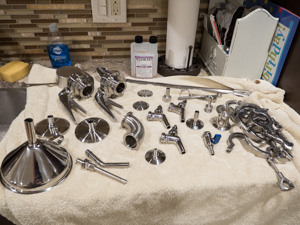[ad_1]
This week partly 4, I cowl widespread beer infections together with wild yeast and micro organism in addition to some tools and materials issues associated to cleansing and sanitation. In Half 1 I offered an introduction to cleansing and sanitation and defined why it’s a two step course of. Half 2 lined cleaners for dwelling brewing and Half 3 mentioned standard sanitizers.
Micro organism, Wild Yeast and Off Flavors
Having gone into some element within the first three components on correctly clear and sanitize your tools, brewers sometimes make errors, so issues can nonetheless go flawed. So how are you going to inform in case your beer has been contaminated? The strongest indication is within the taste and aroma of your beer. So lets talk about what among the commonest micro organism and wild yeasts are and what off-flavors are related to every:
- Lactobacillus – A naturally occurring micro organism on malt and round households. Lactobacillus creates the traditional “bitter beer” taste you’ve tasted if you happen to ever purchased a bitter beer. The bitter taste is a direct results of lactic acid that lactobacillus produces. It may be a persistent bug, persevering with to behave effectively after fermentation is full. It’s extensively used for bitter beer manufacturing.
- Pediococcus – One other naturally occurring micro organism that produces a bitter lactic acid taste together with a buttery taste not in contrast to diacetyl (buttery popcorn). Pediococcus will typically present itself with a hazy end or strands within the beer. Pediococcus can be utilized in bitter beer manufacturing.
- Acetobacter – A micro organism pressure that produces acetic acid as a substitute of lactic acid and manifests itself as a vinegar taste within the completed beer. Acetobacter is a much less widespread an infection in beer because it requires oxygen to breed, so when you’ve got a vinegar flavored beer you will have an oxygen subject in addition to an an infection.
- Wild Yeasts – Like lactobacillus, wild yeast is a quite common an infection as it’s current on most surfaces in your house. Wild yeasts compete in opposition to the yeast you pitch to ferment, however sometimes produce extra off flavors than cultured beer strains. Greater than half of the off flavors listed on the BJCP rating sheet are associated to yeast and these embrace: acetylaldehyde (inexperienced apple taste), excessive fusel alcohols (moonshine flavors), diacetyl (buttery taste), esters (fruity), phenolic (clove, spice, band-aid), solvents (paint thinner), bitter (lactic), sulfur (rotten egg odor) and yeasty. Wild yeasts can even produce lactic acid to allow them to bitter the beer. Whereas it may be troublesome to isolate wild yeast from different yeast issues, I often search for a little bit of sourness plus the presence of one other off taste to point a possible wild yeast.
Tools and Materials Issues
Along with the cleansing and sanitation course of, you additionally want to keep up your tools to maintain it free from issues. Listed here are some widespread issues associated to cleansing and sanitation which can be particular to sure supplies or items of kit.
- Bitter Beer Tools: Some brewers and execs keep separate fermentation vessels and instruments for working with bitter beers as a result of the micro organism used might be very onerous to fully take away, and so they don’t wish to run the danger of cross contamination with their common brewing tools.
- Plastic Tools – Plastic tools has a restricted lifetime as it’s simply scratched and porous. Micro organism and wild yeast can embed itself within the scratches and crevasses, creating an an infection subject. Additionally as plastics age they have a tendency to interrupt down over time, creating further danger. I like to recommend changing your plastic tools periodically.
- Gaskets and Tubing – Gaskets that seal your stainless tools or kegs in addition to silicone or plastic tubing endure from the identical weaknesses as plastic tools. They require thorough cleansing, are simply scratched, are porous and can deteriorate over time. At a minimal you must disassemble gaskets and seals in your tools when cleansing and sanitizing to incorporate pumps, seals on stainless vessels, gaskets on kegs and tubes. Substitute these regularly as they age.
- Aluminum Pots/Pans – Aluminum pots and pans shouldn’t be cleaned with PBW, Bleach, Oxi-Clear, One-Step or different acidic cleaners as these will oxidize the aluminum. That is the one exception the place you must truly use unscented dish cleaning soap to wash your aluminum pots. You shouldn’t use aluminum for fermentation vessels.
- Teflon – You shouldn’t use Saniclean, Starsan or different acidic cleaners with teflon pans.
- Stainless Metal – Bleach can pit chrome steel. As well as, by no means retailer dissimilar metals in your chrome steel pot or fermenter or use steel scouring pads. This will break down the chromium oxide layer that protects the steel and might truly trigger it to rust. As well as some low cost stainless tools is shipped with a skinny layer of oil on it and never correctly passivated (protected). You possibly can learn my article on passivating chrome steel tools for extra info on deal with and restore chrome steel.
This concludes my 4 half sequence on cleansing and sanitation. Please subscribe for normal weekly supply, take a look at the podcast, and don’t hesitate to retweet, hyperlink, like or point out any of my articles on social media.
Associated Beer Brewing Articles from BeerSmith:
Do not make one other dangerous batch of beer! Give BeerSmith a strive – you will brew your greatest beer ever.
Obtain a free 21 day trial of BeerSmith now
[ad_2]


